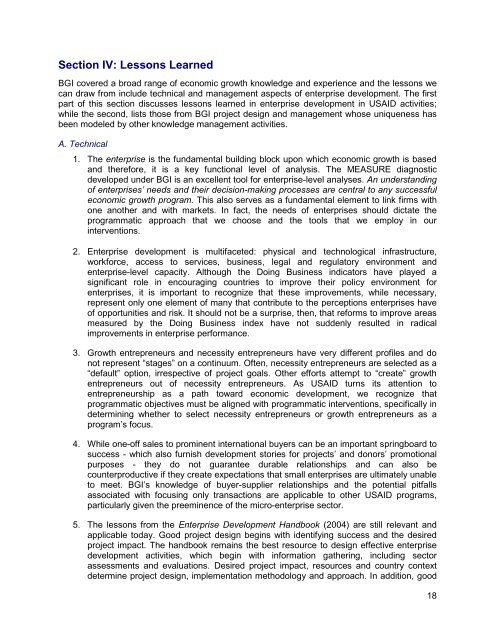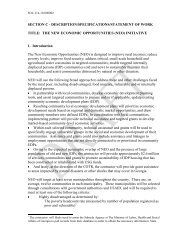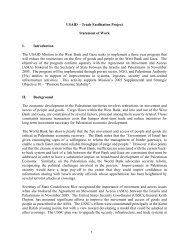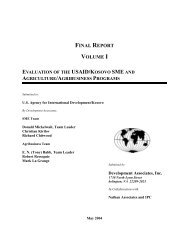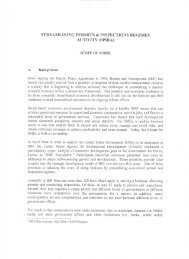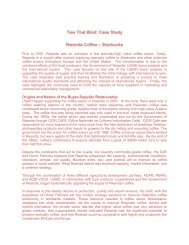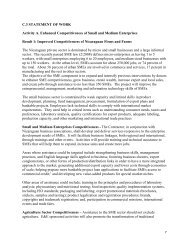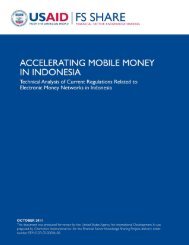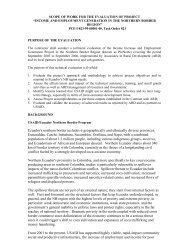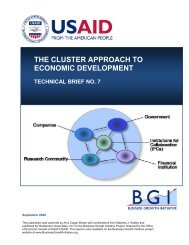BGI Final Report - Economic Growth - usaid
BGI Final Report - Economic Growth - usaid
BGI Final Report - Economic Growth - usaid
Create successful ePaper yourself
Turn your PDF publications into a flip-book with our unique Google optimized e-Paper software.
Section IV: Lessons Learned<strong>BGI</strong> covered a broad range of economic growth knowledge and experience and the lessons wecan draw from include technical and management aspects of enterprise development. The firstpart of this section discusses lessons learned in enterprise development in USAID activities;while the second, lists those from <strong>BGI</strong> project design and management whose uniqueness hasbeen modeled by other knowledge management activities.A. Technical1. The enterprise is the fundamental building block upon which economic growth is basedand therefore, it is a key functional level of analysis. The MEASURE diagnosticdeveloped under <strong>BGI</strong> is an excellent tool for enterprise-level analyses. An understandingof enterprises’ needs and their decision-making processes are central to any successfuleconomic growth program. This also serves as a fundamental element to link firms withone another and with markets. In fact, the needs of enterprises should dictate theprogrammatic approach that we choose and the tools that we employ in ourinterventions.2. Enterprise development is multifaceted: physical and technological infrastructure,workforce, access to services, business, legal and regulatory environment andenterprise-level capacity. Although the Doing Business indicators have played asignificant role in encouraging countries to improve their policy environment forenterprises, it is important to recognize that these improvements, while necessary,represent only one element of many that contribute to the perceptions enterprises haveof opportunities and risk. It should not be a surprise, then, that reforms to improve areasmeasured by the Doing Business index have not suddenly resulted in radicalimprovements in enterprise performance.3. <strong>Growth</strong> entrepreneurs and necessity entrepreneurs have very different profiles and donot represent “stages” on a continuum. Often, necessity entrepreneurs are selected as a“default” option, irrespective of project goals. Other efforts attempt to “create” growthentrepreneurs out of necessity entrepreneurs. As USAID turns its attention toentrepreneurship as a path toward economic development, we recognize thatprogrammatic objectives must be aligned with programmatic interventions, specifically indetermining whether to select necessity entrepreneurs or growth entrepreneurs as aprogram’s focus.4. While one-off sales to prominent international buyers can be an important springboard tosuccess - which also furnish development stories for projects’ and donors’ promotionalpurposes - they do not guarantee durable relationships and can also becounterproductive if they create expectations that small enterprises are ultimately unableto meet. <strong>BGI</strong>’s knowledge of buyer-supplier relationships and the potential pitfallsassociated with focusing only transactions are applicable to other USAID programs,particularly given the preeminence of the micro-enterprise sector.5. The lessons from the Enterprise Development Handbook (2004) are still relevant andapplicable today. Good project design begins with identifying success and the desiredproject impact. The handbook remains the best resource to design effective enterprisedevelopment activities, which begin with information gathering, including sectorassessments and evaluations. Desired project impact, resources and country contextdetermine project design, implementation methodology and approach. In addition, good18


